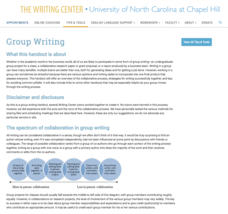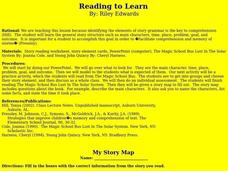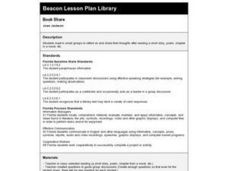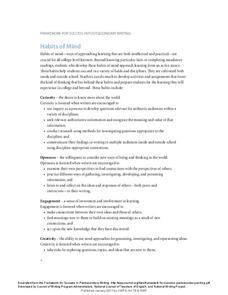Curated OER
Wood
Students practice reading comprehension strategies. In this literacy and science lesson, students read a non-fiction article about wood and locate main ideas and details. Students construct a card game using information taken from the text.
Curated OER
Tomas and the Library Lady
Students practice read aloud comprehension strategies. In this literacy comprehension lesson plan, students listen to Tomas and the Library Lady, stopping to discuss with a partner aspects of the story suggested by the teacher. Students...
Curated OER
Classifying Defending Information about Main Idea
Students read and highlight important information gathered from text. In this reading strategies lesson, students define classify and then classify the important information they find. Students share and reflect on their answers.
Curated OER
Persuade Me, Please! Reading a Persuasive Essay and Liking It!
Persuade your writers that crafting arguments is not that difficult. They only need to follow the steps outlined in this resource.
Curated OER
Guided Imagery: Preparation for Chapter 5 of The Catcher in the Rye
A guided imagery exercise about a favorite person prepares class members for the introduction of Holden Caulfield's brother, in chapter five of J.D. Salinger's famous novel. This focus on Allie emphasizes for readers his importance to...
Novelinks
The Devil’s Arithmetic: Semantic Feature Analysis
Organize the characters in Jane Yolen's The Devil's Arithmetic according to their shared character traits. After listing character traits as a class, kids note which characters exhibit particular characteristics with a discussion and...
University of North Carolina
Group Writing
Two heads are better than one, especially during the writing process. Sometimes, scholars benefit from participating in group writing assignments, as one of the handouts in a series on specific writing assignments outlines. The process...
Curated OER
Do You Know What You Just Read?
Students answer reading comprehension questions using the "story grammar" technique. They listen to a story and then answer questions using the technique: main character, setting, main events, and resolution. Students complete an...
Curated OER
Spring-Aloud Read
Students study the season of spring and create stories about the season. In this spring season lesson, students read books about spring and discuss the season. Students then color and create a mini-book about Spring.
Curated OER
Visualizing While Reading
Third graders listen to the story Where the Wild Things Are, and draw pictures to illustrate what they think is happening. Students share their visualizations with their partners.
Curated OER
Reading to Learn
Students complete story maps in this lesson plan. Students read "The Magic School Bus", and get into groups to choose their story element. Each group shares their information with the class. They then complete a story map for a book...
Curated OER
Active Reading: Finding a Conversation Voice
Young scholars practice reading for comprehension and understanding. In groups, students read, out loud, using a conversation voice. They predict and discuss the story as it unfolds.
Curated OER
Book Share
Sixth graders meet in small groups to reflect on and share their thoughts after reading a short story, poem, or chapter in a novel. Groups of students utilize a book share evaluation worksheet that's imbedded in this plan.
Curated OER
Reading Comprehension Strategy Ideas
Young scholars participate in pre-reading activities, journal keeping, vocabulary lists and other reading comprehension boosters. These activities can be applied to many genres.
Great Books Foundation
Discussion Guide for Little Women
Start with the question in mind with a discussion activity on Louisa May Alcott's Little Women. With four focus questions, note-taking prompts, and discussion points, readers practice answering thematic questions based on textual evidence.
Curated OER
Tangerine: Vocabulary
Here's a great way to make vocabulary words drawn from Edward Bloor's novel Tangerine memorable. Kids create a word square, and in one quadrant write the word. A picture goes in a second quadrant, the definition in a third, and a...
Scholastic
The First Thanksgiving Feast for Grades 3-5
Scholars examine the first Thanksgiving through books and interviews while they complete a KWL chart. Pretending they are part of the feast, learners craft a scrapbook page that features images related to their experience. Pupils reflect...
Novelinks
The Color of Water: Family History Assignment
To conclude their study of James McBride's The Color of Water, class members create their own memoir, focusing on a family member who help shape their life.
Maryland Department of Education
The Concept of Identity Lesson 4: The Psychological Approach
Readers apply Sigmund Freud's theories of the unconscious mind and the psychological approach to literary criticism to analyze and evaluate the relationship between two characters in A Separate Peace.
Novelinks
Tunes for Bears to Dance to: A Letter for Henry
Readers of Tunes for Bears to Dance to are asked to write a personal letter to Henry, the main character in Robert Cormier's young adult novel, offering Henry advice about whether he should do as Mr. Hairston wants.
Melissa Institute for Violence Prevention and Treatment
Concept Muraling
Concept muraling helps learners improve their comprehension of a text by giving them a way to organize their understanding of the key concepts in that text. Introduce readers to this process with a carefully scaffolded lesson plan that...
Oregon Department of Education
Habits of Mind
There is more than one way to approach a problem. Explore the habits of mind as they relate to the methods of approaching learning, and to how young writers can develop success once they learn to foster each skill.
Novelinks
The Little Prince: Brainstorming Activity
What do you think of when you hear the word adult? Or friend? Learners brainstorm with a group of peers to list the words they think of when they hear seven words from Antoine de Saint-Exupéry's The Little Prince.
MENSA Education & Research Foundation
Hurricanes
Learn the ins and outs of hurricanes through a series of lessons answering, "What is a hurricane? How does it travel? How is one formed, measured, and named?" Information is presented through informative text and images, while...

























